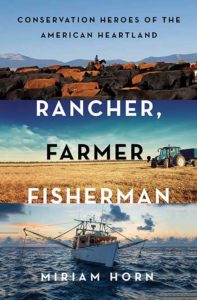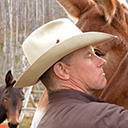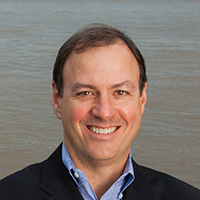The story of a huge, largely hidden, and entirely unexpected conservation movement in America

Unfolding as a journey down the Mississippi River, Rancher, Farmer, Fisherman tells the stories of five representatives of this stewardship movement: a Montana rancher, a Kansas farmer, a Mississippi riverman, a Louisiana shrimper and a Gulf fisherman. In exploring their work, family histories and the essential geographies they protect, Rancher, Farmer, Fisherman challenges pervasive and powerful myths about American and environmental values.
Hero profiles

Montana rancher and former rodeo champion Dusty Crary’s family came West when it was still wild, surviving on bootlegging and coyote trapping before settling in the 1930s on the land he now ranches. There Dusty raises livestock alongside grizzlies and wolves, using grazing to restore native grasslands and manage invasive weeds.
A conservative who generally votes Republican, Dusty has spent countless hours forging alliances between long-time antagonists — cattlemen and federal agencies, hunters and environmental groups — to protect both private ranches and federal wilderness along the Rocky Mountain Front for future generations.
“I think a lot of the skepticism comes from the view that there’s cowboys and there’s hippies and the two shall not get along. Folks think all environmental groups hate cattle and ranchers and there’s certainly some truth to that… But the conservation-minded who do not have an agenda to exclude people realize we’re as organic as everything else here, we’re going to be part of this equation, and that successful initiatives have always been partnerships with those working and living off the land.”

Though the amber waves of grain that stretch across Justin Knopf’s fifth-generation family farm stir nostalgia for America’s rural past, his farming practices are decidedly forward-looking. In his wheat, soy and alfalfa fields, Justin applies the latest advances in microbial soil science, no-till and crop rotation strategies for controlling pests, building soil quality and fighting erosion.
Justin and his family make long-term investments in stewardship, ensuring that the next generations of Knopf farmers will inherit fertile, productive lands and America a secure food supply.
“There’s a perception out there that’s tempting to buy into, that to take care of the environment you have to farm at a scale like my grandfather would have farmed on: a couple hundred acres, with smaller machinery, very limited technology. And I think that’s not quite accurate. As I think about the farmers in our community and probably agriculture as a whole in much of the Midwest, I would argue that many of the larger scale farms are the ones on the cutting edge of environmentalism.”

Merritt Lane, CEO of the Canal Barge Company his grandfather founded in 1933 and descendant of a long line of civic leaders, has stepped up to protect his mariners, American trade and his New Orleans community by helping to lead a $50 billion restoration of Louisiana’s vanishing wetlands. The largest environmental restoration ever undertaken, the project is supported by a coalition that spans interests from oil companies to bird lovers.
The Mississippi River and the ports of Louisiana are the economic engine of the heartland. Companies and farmers depend on the nation’s inland waterways to move $200 billion worth of goods a year into and out of 31 states.
“The issue I often have with the environmentalist conversation is that it doesn’t complete the sentence. It’s just ‘Stop doing this.’ Okay… and then what? It’s not a solution if it kills this company. We have one of the world’s most glorious waterway systems, and we’ve invested billions and billions in these arteries of commerce… If you shut us down, either the stuff doesn’t move and you cripple the economy, or you shift it onto trucks, which are far worse for the environment. The higher ground doesn’t exist just because you call yourself an environmentalist. You have to articulate a stronger value proposition, a way that says, ‘We don’t want you dead; we want you better.'”

When Sandy Nguyen was just five years old, her parents packed up their five children and fled Vietnam in her father’s small fishing boat, eventually settling in New Orleans among other Vietnamese refugee fishermen. The landscape and climate of the Mississippi Delta reminded them of the Mekong, its estuaries providing ample shrimp, crabs and oysters on which to rebuild their livelihoods. Cut off by levees from the River, however, those wetlands are disappearing, eliminating not only critical nurseries for America’s seafood, but also the very land beneath her community’s feet.
As Louisiana begins the ambitious effort to restore the Mississippi River’s vital land-building function, those fishing families look to Sandy, who has devoted her life to helping them, to ensure that their interests are represented. She is the link between high-level planners and politicians and the working men and women who must live with their decisions.
“My fishermen [are] the smartest people when it comes to southeast Louisiana water. All tell me that we have to save our coast. Instead of having to send billions and billions of dollars down for recovery after each hurricane, we need to restore the wetlands. And the marsh areas are where the babies come from. All the shrimp and crabs and seafood that we catch, their life cycle begins in this estuary. So if we lose the estuaries we most likely will lose our industry with it.”

Fisherman Wayne Werner did not set out to become an advocate for smart fishing regulations, but he had to act after seeing how mismanagement was decimating red snapper populations and bringing economic despair to fishing communities, including his own family.
With Wayne’s help, fishermen, environmentalists and the government joined forces to help transition the commercial red snapper fishery to sustainable management practices. Today the population of red snapper, the Gulf’s most valuable fish, is recovering rapidly. Wayne has helped secure abundant supplies of red snapper for commercial fishermen, restaurants and consumers.
“I’m a fisherman at heart; it’s what I’ve known my whole life. I got to see this thing run through the right way. I want to see the fishery remain in the hands of fishermen; and to see the snapper thick, filling the top of the water like an aquarium. I went to my first meeting in 1989, that’s thirty years. I’d like to see this fishery rebuilt before I die.”
About the author
Purchase
Rancher, Farmer, Fisherman is available in hardcover, paperback and audiobook. Buy the book on Amazon.
Also available from Barnes & Noble, IndieBound and iBooks.

